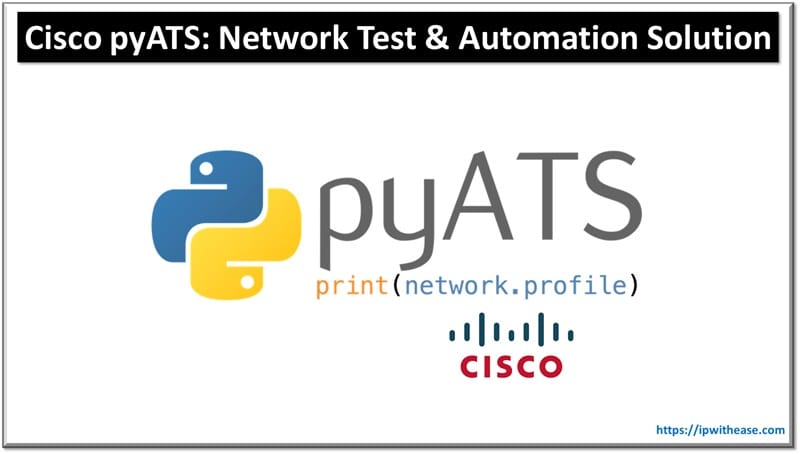Table of Contents
Introduction to Cisco pyATS
Cisco pyATS (Python Automated Test System) is a versatile network testing and automation framework designed for network engineers to automate testing, validation, and operational checks of network infrastructures. Originally developed within Cisco for internal testing, pyATS is now available as an open-source solution, offering powerful automation capabilities to ensure network stability, streamline operational workflows, and accelerate testing processes.

Here’s an overview of how Cisco pyATS works and the key features it offers:
Features of Cisco pyATS
Automated Testing Framework
- Automated Network Testing: pyATS allows for testing of network configurations, connectivity, protocol health, and security policies automatically. These tests can run on-demand or on a schedule, providing quick insights into network health.
- Modular Structure: It has a modular architecture with reusable test scripts, allowing for easy customization and extension across different testing scenarios.
Network Device Interaction (pyATS Genie Library)
- Device Abstraction: With the Genie library, a companion to pyATS, users can interact with network devices across multiple vendors and OS versions. Genie enables abstraction, making scripts more portable and reusable.
- Built-in Parsers: Genie includes parsers for hundreds of network commands across various Cisco OS types, including IOS, IOS-XR, NX-OS, and more. These parsers convert raw command outputs into structured Python data formats, simplifying data extraction and analysis.
End-to-End Network Automation
- Configuration and Compliance Validation: pyATS can validate device configurations and policies against predefined standards, ensuring compliance and reducing configuration drift.
- Operational Data Gathering: Users can collect data like interface status, routing tables, and device health metrics. This data can be compared over time to detect changes or anomalies.
- Change Verification: pyATS can be integrated into change management workflows to verify network changes before, during, and after implementation, which minimizes risk and validates intended outcomes.
Network Health Checks and Diagnostics
- Automated Health Checks: pyATS can continuously monitor network devices, interfaces, and protocols, allowing for early detection of potential issues.
- Diagnostic and Troubleshooting: It can diagnose and troubleshoot network issues by automating checks on device status, connectivity, and protocol operations, reducing manual intervention.
Flexible Scripting and Test Case Management
- Python-Based Scripting: pyATS is entirely Python-based, making it accessible for network engineers familiar with Python and allowing for highly customizable test cases and scripts.
- Testbed YAML Files: Device information and connectivity details are stored in testbed YAML files, making it easy to manage and update network device data across different test cases.
- Multi-Device and Multi-Vendor Support: pyATS supports multiple devices and vendors, making it useful for heterogeneous network environments.
Reporting and Analytics
- Detailed Test Reports: pyATS generates comprehensive reports with information on test results, logs, and errors, aiding in both troubleshooting and performance tracking.
- Comparison Reports: Users can compare historical test results to understand network performance trends, changes, or issues over time.
Use Cases for Cisco pyATS
- Pre- and Post-Change Validation: Automate network checks to ensure changes like software upgrades or configuration updates don’t negatively impact network performance.
- Network Health and Stability Monitoring: Perform continuous or scheduled health checks on critical network infrastructure to catch potential problems before they escalate.
- Compliance Auditing: Validate network devices and configurations against compliance policies, such as security standards or industry regulations.
- Automated Troubleshooting: Enable faster diagnostics by running troubleshooting scripts that identify issues, isolate root causes, and verify corrective actions.
Example Workflow with Cisco pyATS
- Define a Testbed: Create a testbed YAML file that specifies all devices, their IP addresses, OS types, and login credentials.
- Develop Test Scripts: Write Python test scripts that specify the checks or operations to be performed, such as verifying interface status or routing table consistency.
- Execute Tests: Run test scripts against the devices in the testbed. pyATS can run these tests on a single device or across multiple devices simultaneously.
- Generate Reports: After testing, pyATS provides logs and reports detailing any issues or deviations from expected behavior.
- Analyze and Take Action: Use the insights to troubleshoot issues, validate changes, or ensure network compliance.
Benefits of Using Cisco pyATS
- Consistency and Accuracy: Automated scripts reduce human error and improve the accuracy of network testing.
- Time and Cost Savings: Automating repetitive testing tasks saves time, reduces operational costs, and improves efficiency.
- Scalability: pyATS scales well across large networks, supporting multi-device testing and allowing for complex test scenarios.
- Proactive Problem Detection: Automated health checks and diagnostics ensure that issues are detected and addressed promptly.
Getting Started with Cisco pyATS
- Install pyATS: Install pyATS using pip (Python’s package manager) with the command pip install pyats[full].
- Create Testbeds and Scripts: Define devices in YAML testbed files and write Python scripts that interact with the network devices.
- Run and Monitor Tests: Execute tests and monitor results, using pyATS Genie for parsing outputs and analyzing results.
Cisco pyATS provides an accessible and robust solution for network automation, enhancing testing efficiency and network reliability for enterprise environments. Its ability to simplify complex network automation tasks makes it valuable for both routine operations and complex change management initiatives.
ABOUT THE AUTHOR

You can learn more about her on her linkedin profile – Rashmi Bhardwaj



